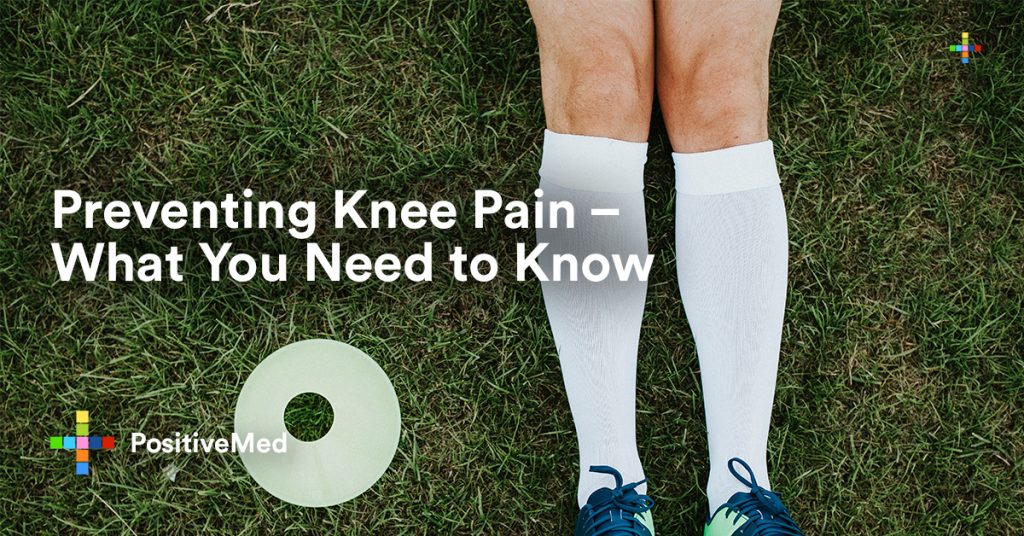One of the most common pain complaints doctors here from adult patients? Knee pain! Why? As one of the largest joints in your body, the knee plays an important role in supporting your every movement as well as absorbing the shock to your body from walking and running. Everything from running too much to being overweight can affect how your knees feel and support you. If you’re looking to prevent knee pain, don’t miss these must-read tips:

Weight Management
Managing a healthy weight with lots of exercises and a balanced diet doesn’t just do your heart, bones, brain, and muscles good – it’s critical to your joints as well! Being overweight or obese negatively impacts joint health by placing added stress and pressure on the connective tissues (ligaments, tendons) that hold joints together.
The more weight you carry around as well, especially around the midsection, can alter your center of gravity and throw your own pronation off (the way you walk). Incorrect walking form over time can lead to a pulling and straining of foot and leg muscles which connect to the knees and hip, resulting in chronic knee pain and a downturn in activity levels.
Self-Monitoring
Noticing a popping or clicking sound when you bend and flex your knee? Nursing a nagging knee ache when you go running? Monitoring your own pain and symptoms, visible or not visible, equips you with the body awareness you need in order to know when it’s time to go see the doctor.
Waiting until your knee pain worsens or you incur an injury simply isn’t a good idea, as leg injuries (more than any other injury) can greatly affect your activity levels and your mobility. Ending up on crutches even temporarily can strike a blow to your workout routine and make it much harder to get to and from work, much less anywhere else like school or the store. Some knee pain can derive from non-injury causes as well as arthritis or bursitis, making a medical evaluation even more pertinent.
Bracing / Wrapping
Supporting healthy, fluid knee movement may be aided by orthotic aids like knee braces, compression sleeves, wraps, or Kinesio tape. Especially for people who have experienced a knee injury before, reinforcing strong knee movement by helping stabilize and compress the joint with a brace or wrap can keep you active and enjoying the sports and hobbies you love.
Unsuspecting orthotics like an IT band strap can help relieve knee pain associated with upper leg and hip issues too. For example, with IT band syndrome, the long connective tendon that runs along the outside of the thigh can begin to run against the thigh bone with overuse, resulting in knee pain. A strap that goes around the thigh can help prevent those symptoms.
Stretching and Strengthening
Sure stretching and strengthening muscles in your core and back can help prevent low back pain, but your knee joints? Does that same thought apply to them? Absolutely. When knee joints are tight, stiff, or inflamed, the range of motion becomes limited and the pain factor increases.
By regularly stretching and strengthening the knee joint and connected muscles (calf muscle, hamstring, etc), you can boost your knee health for the better. Flexibility-focused exercises like yoga, Pilates, dancing, and general every day stretching make it easy to keep knee joints loosened and leg muscles pliable and elastic, helping prevent injury.
Practicing Good Posture
Does your 9 to 5 have you sitting down at a computer all day? Spending your weekends vegging out to Netflix on the couch? Sedentary lifestyles not only lead to weight gain which negatively impacts knee health but bad posture too.
Slouching, slumping, craning the neck and head past the shoulders – all these poor body positions lead to low back pain, hip imbalance, rounded shoulders, and painful spinal compression. When your posture suffers, so do your hips and knees. You might find yourself compensating for tight back muscles when walking or running by leaning forward more with your steps, placing unnecessary pressure on the knee joint.
Avoiding Overuse
A good many knee injuries and sources of inflammation and pain can be narrowed down to one cause – general overuse. Overuse often stems from running long distances, spending a career squatting or bending, or massively increasing the incline on which you exercise or run. When it comes to the knee joint, overuse leads to a wearing down of cartilage, damage and tearing of connective tendons and ligaments, and swelling of strained tendons.
If you are concerned about overuse, consider ditching long distance running every day of the week for one day of cross-training. Dip your toe into different sports or activities like swimming, hiking, or cycling – you’ll still get a great workout, but will avoid the high-impact nature of other sports that put a lot of stress on your knees.







